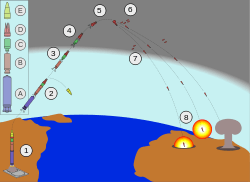Latest News for: intercontinental ballistic missile
Edit
Russia steps up talk of nuclear response as Ukraine uses western missiles
The Times/The Sunday Times 19 Nov 2024
... American long-range missile ... A Yars intercontinental ballistic missile is launched during a test from the Plesetsk cosmodrome in Russia ... What are Storm Shadow missiles? The long-range weapons explained.
Edit
Putin lowers the threshold for using his nuclear arsenal after Biden's arms decision for Ukraine
The Day 19 Nov 2024
Edit
Putin signs new Russian nuclear doctrine after Biden’s arms decision for Ukraine
The Oneida Daily Dispatch 19 Nov 2024
Edit
Kremlin threatens
The Daily Mail 19 Nov 2024
Yars intercontinental ballistic missile being launched as part of nuclear deterrence forces drills from the Plesetsk Cosmodrome, in Arkhangelsk Oblast, northwestern Russia, 29 October 2024.
Edit
Kim Jong Un Meets With Russia’s Natural Resources Minister in Pyongyang
Moscow Times 19 Nov 2024
A separate Russian military academy delegation also arrived in Pyongyang, although KCNA provided no further details on their visit ... Recently, North Korea test-fired ballistic missiles and a new solid-fuel intercontinental ballistic missile ... Preview.
Edit
Ukraine fires US-made missile into Russia: WW3 fears as Kremlin threatens
The Daily Mail 19 Nov 2024
Edit
Putin issues warning to United States with new nuclear doctrine after Biden allows Ukraine to ...
New York Post 19 Nov 2024
Edit
Putin signs law allowing a nuclear strike: Kremlin leader lowers threshold for justifying nuke...
The Daily Mail 19 Nov 2024
A Yars intercontinental ballistic missile is launched as part of nuclear deterrence forces drills from the Plesetsk Cosmodrome, in Arkhangelsk Oblast, northwestern Russia, 29 October 2024 ... Ukraine fires first US-made missile into Russia.
Edit
Will Trump Forge ‘Deal-of-the-Century’ Again?
Kashmir Observer 19 Nov 2024
... has once again stunned the world! Iran has successfully tested an Intercontinental Ballistic> Missile (ICBM), according to DefenseSecurityAsia which is capable of hitting its target up to 5500 kms.
Edit
What are ATACMS, the US missiles just cleared for use against Russia?
The Times of India 18 Nov 2024
Edit
Atacms missiles: what are they and why are they important for Ukraine?
AOL 18 Nov 2024
Ballistic> missiles fly much ... Atacms are considered long-range, although they do not have the range of a cruise or intercontinental ballistic missile.Why has the Biden administration changed position?.
Edit
US nuclear-powered submarine arrives in Busan to replenish supplies
Korea Times 18 Nov 2024
11. Yonhap ... submarine's arrival came amid heightened tensions on the Korean Peninsula following North Korea's launch of an intercontinental ballistic missile last month and continued sending of trash-carrying balloons across the border ... (Yonhap). .
Edit
 The Lexington Dispatch
18 Nov 2024
The Lexington Dispatch
18 Nov 2024
North Korean leader calls for expanding nuclear forces
 The Lexington Dispatch
18 Nov 2024
The Lexington Dispatch
18 Nov 2024
... the development of his nuclear-armed military, which now has various nuclear-capable systems targeting South Korea and intercontinental ballistic missiles that could potentially reach the U.S.
Edit
Trump, the self-proclaimed peacemaker, should channel and exceed his inner Reagan
The Hill 18 Nov 2024
Edit
Kim Jong-un vows to expand his nuclear weapons
The Daily Mail 18 Nov 2024
North Korean media handout claiming to show a test-fire of the new Hwasong-19 intercontinental ballistic missile ... North Korea recently fired a salvo of ballistic missiles and tested a new solid-fuel ICBM.
- 1
- 2
- Next page »



